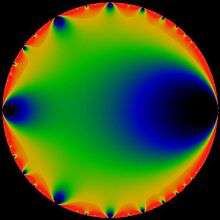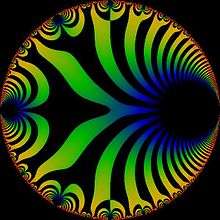Dedekind eta function
In mathematics, the Dedekind eta function, named after Richard Dedekind, is a modular form of weight 1/2 and is a function defined on the upper half-plane of complex numbers, where the imaginary part is positive. It also occurs in bosonic string theory.

Definition
For any complex number with , let , then the eta function is defined by,
The notation is now standard in number theory, though many older books use q for the nome . Raising the eta equation to the 24th power and multiplying by (2π)12 gives
where Δ is the modular discriminant. The presence of 24 can be understood by connection with other occurrences, such as in the 24-dimensional Leech lattice.
The eta function is holomorphic on the upper half-plane but cannot be continued analytically beyond it.


The eta function satisfies the functional equations[1]
More generally, suppose a, b, c, d are integers with ad − bc = 1, so that
is a transformation belonging to the modular group. We may assume that either c > 0, or c = 0 and d = 1. Then
where
Here is the Dedekind sum
Because of these functional equations the eta function is a modular form of weight 1/2 and level 1 for a certain character of order 24 of the metaplectic double cover of the modular group, and can be used to define other modular forms. In particular the modular discriminant of Weierstrass can be defined as
and is a modular form of weight 12. (Some authors omit the factor of (2π)12, so that the series expansion has integral coefficients).
The Jacobi triple product implies that the eta is (up to a factor) a Jacobi theta function for special values of the arguments:
where is "the" Dirichlet character modulo 12 with , . Explicitly,
The Euler function
related to by , has a power series by the Euler identity:
Because the eta function is easy to compute numerically from either power series, it is often helpful in computation to express other functions in terms of it when possible, and products and quotients of eta functions, called eta quotients, can be used to express a great variety of modular forms.
The picture on this page shows the modulus of the Euler function: the additional factor of between this and eta makes almost no visual difference whatsoever (it only introduces a tiny pinprick at the origin). Thus, this picture can be taken as a picture of eta as a function of q.
Combinatorial identities
The theory of the algebraic characters of the affine Lie algebras gives rise to a large class of previously unknown identities for the eta function. These identities follow from the Weyl–Kac character formula, and more specifically from the so-called "denominator identities". The characters themselves allow the construction of generalizations of the Jacobi theta function which transform under the modular group; this is what leads to the identities. An example of one such new identity[3] is
where is the q-analog or "deformation" of the highest weight of a module.
Special values
The above connection with the Euler function together with the special values of the latter, it can be easily deduced that
Eta quotients
Eta quotients are defined by quotients of the form
Where is a non-negative integer and is any integer. Linear combinations of eta quotients at imaginary quadratic arguments may be algebraic, while combinations of eta quotients may even be integral. For example, define,
with 24th power of the Weber modular function . Then,
and so on, values which appear in Ramanujan–Sato series.
Eta Quotients may also be a useful tool for describing bases of modular forms, which are notoriously difficult to compute and express directly. In 1993 Basil Gordon and Kim Hughes proved that if an eta quotient of the form satisfies
then is a weight modular form for the congruence subgroup (up to holomorphicity) where
This result was extended in 2019 such that the converse holds for cases when is coprime to , and it remains open that the original theorem is sharp for all integers .[5] This also extends to state that any modular eta quotient for any level congruence subgroup must also be a modular form for the group . While these theorems characterize modular eta quotients, the condition of holomorphicity must be checked separately using a theorem that emerged from the work of Gérard Ligozat[6] and Yves Martin[7]:
If is an eta quotient satisfying the above conditions for the integer and and are coprime integers, then the order of vanishing at the cusp relative to is
- .
These theorems provide an effective means of creating holomorphic modular eta quotients, however this may not be sufficient to construct a basis for a vector space of modular forms and cusp forms. A useful theorem for limiting the number of modular eta quotients to consider states that a holomorphic weight modular eta quotient on must satisfy
where denotes the largest integer such that .[8] These results lead to several characterizations of spaces of modular forms that can be spanned by modular eta quotients.[9] Using the graded ring structure on the ring of modular forms, we can compute bases of vector spaces of modular forms composed of -linear combinations of eta-quotients. For example, if we assume is a semiprime then the following process can be used to compute an eta-quotient basis of .[10]
Step 1: Fix a semiprime which is coprime to 6. We know that any modular eta quotient may be found using the above theorems, therefore it is reasonable to algorithmically to compute them.
Step 2: Compute the dimension of . This tells us how many linearly independent modular eta quotients we will need to compute to form a basis.
Step 3: Reduce the number of eta quotients to consider. For semiprimes we can reduce the number of partitions using the bound on
and by noticing that the sum of the orders of vanishing at the cusps of must equal
- .[11]
Step 4: Find all partitions of into 4-tuples (there are 4 cusps of ), and among these consider only the partitions which satisfy Gordon and Hughes' conditions (we can convert orders of vanishing into exponents). Each of these partitions corresponds to a unique eta quotient.
Step 5: Determine the minimum number of terms in the q-expansion of each eta quotient required to identify elements uniquely (this uses a result known as Sturm's Bound). Then use linear algebra to determine a maximal independent set among these eta quotients.
Step 6: Assuming that we have not found many linearly independent eta quotients. Find an appropriate vector space such that and is spanned by (weakly holomorphic) eta quotients,[12] and contains an eta quotient .
Step 7: Take a weight modular form not in the span of our computed eta-quotients and compute as a linear combination of eta-quotients in and then divide out by . The result will be an expression of as a linear combination of eta quotients as desired. Repeat this until a basis is formed.
See also
References
- Siegel, C.L. (1954). "A Simple Proof of ". Mathematika. 1: 4. doi:10.1112/S0025579300000462.
- Bump, Daniel (1998), Automorphic Forms and Representations, Cambridge University Press, ISBN 0-521-55098-X
- Fuchs, Jurgen (1992), Affine Lie Algebras and Quantum Groups, Cambridge University Press, ISBN 0-521-48412-X
- Basil Gordon and Kim Hughes. Multiplicative properties of η-products. II. In A tribute to Emil Grosswald: number theory and related analysis, volume 143 of Contemp. Math., pages 415–430. Amer. Math. Soc., Providence, RI, 1993.
- Michael Allen et al. “Eta-quotients of Prime or Semiprime Level and Elliptic Curves”. In: arXiv e-prints, arXiv:1901.10511 (Jan. 2019), arXiv:1901.10511. arXiv:1901.10511 [math.NT].
- G. Ligozat. Courbes modulaires de genre 1. U.E.R. Mathématique, Université Paris XI, Orsay, 1974. Publication Mathématique d’Orsay, No. 75 7411.
- Yves Martin. Multiplicative η-quotients. Trans. Amer. Math. Soc., 348(12):4825–4856, 1996.
- Jeremy Rouse and John J. Webb. On spaces of modular forms spanned by eta-quotients. Adv. Math., 272:200–224, 2015.
- Jeremy Rouse and John J. Webb. On spaces of modular forms spanned by eta-quotients. Adv. Math., 272:200–224, 2015.
- Michael Allen et al. “Eta-quotients of Prime or Semiprime Level and Elliptic Curves”. In: arXiv e-prints, arXiv:1901.10511 (Jan. 2019), arXiv:1901.10511. arXiv:1901.10511 [math.NT].
- Michael Allen et al. “Eta-quotients of Prime or Semiprime Level and Elliptic Curves”. In: arXiv e-prints, arXiv:1901.10511 (Jan. 2019), arXiv:1901.10511. arXiv:1901.10511 [math.NT].
- Jeremy Rouse and John J. Webb. On spaces of modular forms spanned by eta-quotients. Adv. Math., 272:200–224, 2015.
Further reading
- Tom M. Apostol, Modular functions and Dirichlet Series in Number Theory (2 ed), Graduate Texts in Mathematics 41 (1990), Springer-Verlag, ISBN 3-540-97127-0 See chapter 3.
- Neal Koblitz, Introduction to Elliptic Curves and Modular Forms (2 ed), Graduate Texts in Mathematics 97 (1993), Springer-Verlag, ISBN 3-540-97966-2